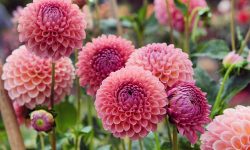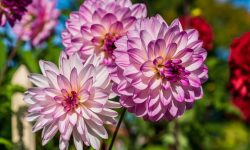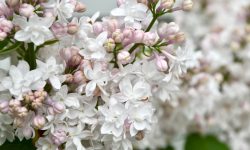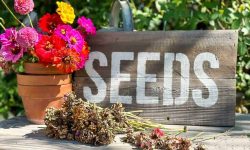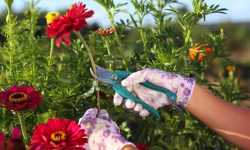Bleeding hearts, with their enchanting heart-shaped blossoms dangling from graceful arching stems, bring an unmatched elegance to spring gardens. Their pastel shades—ranging from soft pinks to pure whites—add a gentle, romantic presence that instantly softens shaded corners, woodland beds, or cottage-style borders. Few perennials evoke such emotional charm while thriving in cool, filtered light beneath trees or alongside ferns and hostas.
To keep this perennial favorite blooming beautifully year after year, gardeners need more than admiration—they need a smart, seasonal care routine. From choosing the right planting spot to mastering moisture and soil conditions, understanding how to grow bleeding hearts is essential. This guide will walk you through every stage of their life cycle, ensuring your garden enjoys their delicate beauty spring after spring.
Understanding Bleeding Hearts: A Springtime Gem
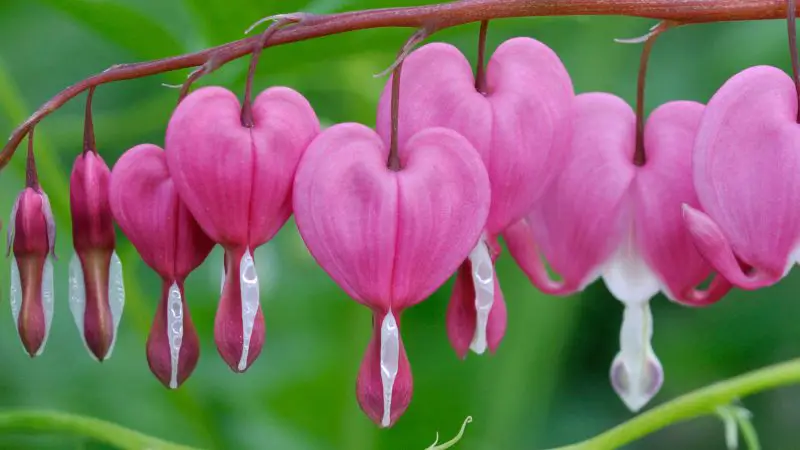
Botanical Characteristics and Varieties
Bleeding hearts, classified under the genus Lamprocapnos, are known for their iconic heart-shaped flowers that bloom in early spring. The most recognized species is Lamprocapnos spectabilis, featuring arching stems lined with pink and white blossoms. A popular variant, ‘Alba’, offers elegant white flowers and bright green foliage, adding contrast to shaded spaces.
For compact gardens or containers, cultivars like ‘Valentine’ display deep red flowers and stronger stems. Native species such as Dicentra eximia and Dicentra formosa have fern-like leaves and longer bloom times, making them ideal for naturalistic or woodland-style gardens. Their finely divided foliage adds texture and charm even after the flowers fade, providing multi-season interest.
Ideal Garden Conditions for Success
When and How to Plant Bleeding Hearts
Best Planting Time for Bleeding Hearts
The ideal time to plant bleeding hearts depends on the local climate and the form in which the plant is purchased. For bare-root bleeding hearts, early spring or fall is best, when soil temperatures are cool and natural moisture levels are higher. This gives the roots time to establish before the plant focuses on flowering or dormancy.
In regions with cold winters, planting in early spring just after the last frost allows bleeding hearts to take advantage of the full growing season. In milder climates, fall planting works well, as roots can settle in while the weather is still temperate. Container-grown plants offer more flexibility and can be planted any time from spring through early fall, provided they are kept well watered and protected from heat extremes.
Choosing the Right Planting Location
Selecting the proper location is crucial for long-term success. Bleeding hearts flourish in areas with partial to full shade, especially where they receive filtered sunlight or morning light followed by afternoon shade. Avoid full sun locations in warmer climates, as prolonged exposure to heat can lead to scorched leaves or early dormancy.
Ideal planting spots include shaded borders, woodland gardens, or under deciduous trees that allow light in during early spring but provide canopy coverage during hotter months. A sheltered position, protected from strong wind or heavy foot traffic, also helps maintain the integrity of their delicate stems.
Preparing the Soil for Planting
Before planting, soil preparation should focus on drainage and fertility. Bleeding hearts need soil that retains moisture but doesn’t remain soggy. Heavy clay soils can be amended with compost, leaf mold, or coarse sand to improve aeration and drainage. Sandy soils, on the other hand, may benefit from added organic matter to increase moisture retention and nutrient content.
The planting hole should be wide and deep enough to accommodate the root system without crowding. For bare-root plants, the crown should be placed just below soil level and covered with a few inches of soil. For potted plants, transplant carefully without disturbing the roots, positioning the crown even with the soil surface.
Watering and Mulching After Planting
After planting, water the area thoroughly to settle the soil around the roots and eliminate air pockets. Consistent moisture is essential during the first few weeks of establishment, especially in dry conditions. However, overwatering should be avoided, particularly in cooler weather, as overly wet soil can lead to root rot.
A two- to three-inch layer of organic mulch, such as shredded leaves or bark, helps retain soil moisture, suppress weeds, and regulate temperature. Be sure to keep the mulch a few inches away from the crown of the plant to prevent rot or fungal issues.
Monitoring Early Growth
New growth may take a few weeks to emerge, especially if planting was done early in spring while soil temperatures are still low. Patience is key, as bleeding hearts often develop slowly but steadily. Once foliage appears, keep an eye out for signs of stress such as yellowing or wilting, which may indicate too much sun, insufficient water, or poor drainage.
With careful attention during the planting phase and proper site preparation, bleeding hearts will reward gardeners with years of elegant spring blooms and graceful foliage.
Proper Watering and Fertilization Techniques
Bleeding hearts require consistent moisture, especially during their active growing season in spring and early summer. The key is to maintain evenly moist soil without allowing it to become soggy. Overwatering can lead to root rot, while underwatering may cause premature dormancy or stress. In well-draining soil enriched with organic matter, watering once or twice a week is usually sufficient, depending on rainfall and temperature. During dry spells or windy conditions, check the soil frequently and adjust as needed to prevent it from drying out.
When it comes to fertilization, bleeding hearts are not heavy feeders but do benefit from balanced nutrition. A light application of a slow-release, balanced fertilizer (such as 10-10-10) in early spring helps support strong root development and healthy flowering. Alternatively, a top dressing of compost or aged manure can be used to enrich the soil organically. Avoid high-nitrogen fertilizers, as these can lead to excessive foliage growth at the expense of blooms. Once flowering tapers off and the plant begins to decline into dormancy, additional feeding is unnecessary for the rest of the year. Proper moisture and moderate feeding are essential to maintain vibrant, long-lived plants.
Seasonal Growth and Flowering Expectations
Bleeding hearts follow a distinct seasonal rhythm that reflects their woodland origins. In early spring, as temperatures warm and daylight increases, dormant roots begin sending up delicate shoots. These shoots quickly develop into arching stems lined with the plant’s signature heart-shaped flowers, usually blooming from mid to late spring depending on the climate zone. Flowering typically lasts four to six weeks, creating a stunning but brief highlight in the garden.
As summer approaches and temperatures rise, bleeding hearts naturally begin to fade. The foliage yellows and eventually dies back, signaling the plant’s transition into summer dormancy. This is a normal part of their life cycle and not a sign of poor health. Gardeners should resist the urge to remove fading foliage too early, as it helps the plant store energy for the next season.
In cooler climates, or when grown in consistently moist, shaded environments, some bleeding heart varieties may maintain their foliage longer or rebloom lightly. However, most will disappear entirely by midsummer, resting until the following spring. Understanding this cycle helps gardeners plan around their dormancy and maintain visual interest in garden beds by pairing bleeding hearts with later-emerging perennials or groundcovers.
Mulching and Weed Management for Healthy Roots
Dividing and Propagating Bleeding Hearts
Dividing bleeding hearts is a practical way to rejuvenate older plants and expand your garden. The best time to divide is in early spring as new shoots emerge or in fall after dormancy. Carefully dig up the root clump, then use a clean, sharp knife to separate it into sections, each with roots and healthy buds. Replant divisions immediately at the same depth and water well to help them establish.
For propagation, gardeners can also use root cuttings or start from seed, though seeds take longer to mature. Root cuttings should be taken in late winter, stored in moist medium, and planted once new growth appears. While division is the fastest and most reliable method, both techniques allow you to grow more of these graceful spring favorites with minimal effort.
Container Growing Tips for Bleeding Hearts
Growing bleeding hearts in containers offers flexibility for gardeners with limited space or those looking to highlight these elegant plants on patios, balconies, or shaded entryways. While these perennials are traditionally grown in woodland borders or garden beds, they adapt well to pots when given the proper conditions and care.
Choosing the right container is essential. Select a pot that is at least 12 to 14 inches in diameter and has sufficient drainage holes to prevent water from pooling at the bottom. Bleeding hearts have fleshy, moisture-sensitive roots that are highly susceptible to rot if left in soggy soil. Use a high-quality potting mix enriched with compost or peat moss to retain moisture without becoming waterlogged. Avoid heavy garden soil, which can compact over time and hinder root development.
Placement is key to success. Situate the container in a spot with morning sun and afternoon shade or bright, dappled light throughout the day. Avoid exposing the plant to intense, direct sunlight, especially in summer, as this can cause leaf scorch and premature dormancy. During hot spells, move the pot to a more sheltered location or use shade cloth for added protection.
Water consistently to keep the soil evenly moist during the active growing season in spring and early summer. Container-grown bleeding hearts dry out more quickly than those in the ground, so frequent monitoring is important, especially during warmer weather. Reduce watering gradually once the foliage begins to yellow and the plant enters dormancy in mid to late summer.
Fertilizing every four to six weeks with a balanced, water-soluble fertilizer during active growth helps maintain healthy foliage and encourage strong flowering. Avoid over-fertilizing, which can lead to excessive leafy growth at the expense of blooms.
In colder climates, containers should be moved to a sheltered area, such as an unheated garage or cold frame, once the plant goes dormant. This protects the roots from freezing temperatures, which can be more damaging in pots than in-ground. Alternatively, use frost-resistant containers and insulate them with straw or wrap the pot in burlap during winter months.
Pest and Disease Prevention Strategies
Bleeding hearts add a touch of timeless charm to shaded or semi-shaded garden spaces. Their signature heart-shaped flowers on arching stems create a soft, romantic effect that works beautifully in woodland gardens, cottage-style borders, and serene courtyard settings. These plants pair well with other shade-loving perennials like ferns, hostas, brunnera, and astilbes, offering both textural and color contrast.
To make the most of their visual appeal, place bleeding hearts near walkways, garden benches, or front borders where their delicate structure can be appreciated up close during peak spring bloom. Because they go dormant by midsummer, it’s wise to combine them with later-season companions that can fill in the space and maintain interest—plants like Japanese forest grass, heuchera, or shade-tolerant ornamental grasses are excellent choices.
Designing with bleeding hearts also involves considering light and moisture conditions. Dappled sunlight beneath deciduous trees provides an ideal environment, allowing for vibrant spring flowers followed by natural summer dormancy. Whether used as a focal point or a soft background accent, bleeding hearts contribute grace and longevity to thoughtfully planned garden compositions.
Encouraging Naturalizing and Long-Term Success
Bleeding hearts are well-suited for naturalizing in woodland gardens and shaded borders, where they can return year after year with minimal intervention. To encourage this long-term success, it’s essential to create an environment that mimics their native habitat—cool, moist, and rich in organic matter.
One of the best ways to promote naturalizing is by allowing plants to go to seed naturally. After blooming, if the flower stalks are left intact, bleeding hearts may produce seed pods that eventually scatter in the surrounding soil. While not all cultivars will self-seed freely, species forms like Lamprocapnos spectabilis and native varieties tend to reseed modestly, slowly forming larger clumps over time.
In addition to seeding, healthy clump expansion through underground roots contributes to a fuller presence in the garden each spring. Leaving plants undisturbed for several seasons allows them to establish a stable root system. However, dividing mature plants every few years helps rejuvenate growth, prevent overcrowding, and extend their blooming potential.
To support long-term vigor, maintaining soil fertility is crucial. An annual top-dressing of compost or aged leaf mold improves soil structure and nutrient availability without disturbing the roots. Mulching each fall also helps protect the crown during winter, suppress weeds, and regulate moisture.
Minimizing stress during the plant’s active growing period—particularly from drought, heat, or competition from aggressive nearby plants—is vital for sustainability. Bleeding hearts naturally go dormant in summer, and this phase should be respected without overwatering or unnecessary disturbance. Gardeners can plan for companion plants that fill in gaps during dormancy, preserving visual interest and ensuring the garden remains vibrant.
Frequently Asked Questions (FAQ)
What is the best time of year to plant bleeding hearts?
The ideal time to plant bleeding hearts is in early spring or fall, depending on your climate. Spring planting is great for bare-root divisions or nursery starts, allowing them to establish before summer dormancy. In mild climates, fall planting gives roots time to settle over winter, leading to stronger growth in spring.
Do bleeding hearts prefer sun or shade?
Bleeding hearts thrive best in partial to full shade conditions. They prefer dappled sunlight, like that found under deciduous trees. Too much direct sun—especially in the afternoon—can cause stress, lead to wilting, or shorten the blooming season. In cooler climates, they may tolerate more sun if soil moisture is adequate.
How often should I water bleeding hearts?
Bleeding hearts need consistently moist but well-drained soil. During active growth in spring, water regularly to maintain even moisture—about once or twice a week depending on rainfall. Avoid soggy conditions, especially in clay soils. During summer dormancy, reduce watering, allowing the soil to dry slightly between waterings.
Can I grow bleeding hearts in containers?
Yes, bleeding hearts can grow well in containers, especially compact varieties like ‘Alba’ or ‘Luxuriant’. Use a deep container with drainage holes, filled with rich, organic potting mix. Keep the soil moist in spring and move the container to a cooler, shaded location during dormancy to mimic natural conditions.
When do bleeding hearts bloom, and how long do the flowers last?
Bleeding hearts typically bloom from mid to late spring. In favorable conditions, flowering may last for 4 to 6 weeks. Cool temperatures and consistent moisture can extend the blooming period. After flowering, the foliage begins to yellow as the plant prepares for dormancy in early to midsummer.
Do bleeding hearts go dormant? What should I do when they do?
Yes, bleeding hearts naturally go dormant in summer. The foliage will yellow and die back completely. This is normal and not a sign of disease. During dormancy, reduce watering and avoid disturbing the roots. You can plant companion perennials nearby to fill the gap and maintain garden interest.
How do I divide bleeding hearts?
Division is best done in early spring or late fall when the plant is dormant or just emerging. Use a clean, sharp spade or knife to divide large clumps, ensuring each section has roots and a few buds. Replant divisions promptly in moist, rich soil, and water thoroughly to help them settle.
What pests or diseases should I watch for?
While relatively trouble-free, bleeding hearts can occasionally suffer from aphids, slugs, snails, and powdery mildew. Aphids can be managed with neem oil or insecticidal soap. Good airflow and spacing help prevent fungal issues. Avoid overhead watering, and remove any affected foliage promptly.
Can I grow bleeding hearts from seed?
Yes, although it requires patience. Seeds must be cold stratified—chilled in moist soil—for several weeks before planting. Sow in late fall or early spring, and expect germination in the following spring. Seed-grown plants may take 2–3 years to reach flowering maturity.

